The first woman leader of a twentieth-century Western superpower died on Monday, April 8 at the age of 87. A conservative politician having been trained at Oxford as a chemist, Margaret Thatcher was a woman who described herself in uncompromising terms: “I am not a consensus politician, I am a conviction politician.” There is an appealing confidence to that statement. She was loathed at least as much as she was admired and respected. She served three terms as Prime Minister of the United Kingdom from 1979 to 1990, and in that time had an enormous economic and cultural impact on England and the world, wrenching the British economy from union-fortified socialism to unapologetic capitalism. Cartoonists in England were there lending their unique strain of commentary and derision from beginning to end. Here is a sampling.
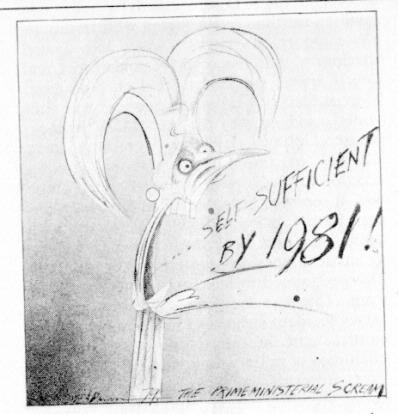
“Prime Ministerial Scream,” by Ralph Steadman, published in New Statesman, July 6, 1979
Ralph Steadman, probably the most well known of this group of illustrators to Americans, became a regular contributor to Punch magazine in the 60s, while he was also attending London College Printing and Graphic Arts College and East Ham Technical College. In 1969 Steadman covered the Kentucky Derby, on assignment, with Hunter S. Thompson. Their collaborative work appeared in Scanlan’s Weekly and marked the beginning of their Gonzo journalism adventure, the most famous product of which is the novel (written by Thompson and illustrated by Steadman) Fear and Loathing in Las Vegas.
* * * *
The congenial relationship between Margaret Thatcher and Ronald Reagan has been well documented; Thatcher, who had privately voiced her scientific skepticism about Reagan’s Strategic Defense Initiative (popularly known as “Star Wars”), publically supported it with the knowledge that British businesses would get a piece of the action with research and development funding. Still, she was none too pleased with the U.S. invasion of Grenada in 1983, Operation Urgent Fury. Grenada had been a territory of the British Commonwealth until 1974.
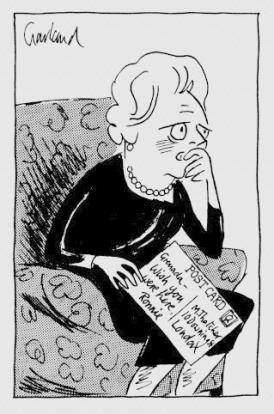
By Nicholas Garland, published in the Sunday Telegraph, October 29, 1983
Nicholas Garland, born in 1935, spent most of his childhood in New Zealand but studied art at the Slade School of Art in London. He became the Daily Telegraph’s first political cartoonist in 1966, and is best known for illustrating the comic strip lampooning the adventures of an Australian vulgarian abroad, “Barry Mackenzie,” written by Barry Humphries, published in Private Eye.
* * * *
Thatcher’s second term as Prime Minister was marked by the strike of the National Union of Mineworkers. Union president Arthur Scargill called a walkout on March 6, 1984, illegally, resulting in the workers not being eligible for benefits during the long, violent strike. The strike lasted a year and was unsuccessful—this was a defining moment in labor history and the privatization of industry.
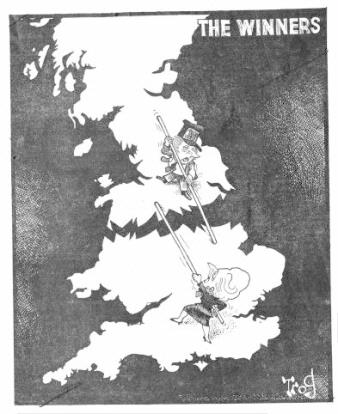
“The Winners” by Wally Fawkes (“Trog”), published in the Observer, January 27, 1985
Wally Fawkes (born in 1924—one year before Thatcher) was both a jazz musician and a political cartoonist. His career as an artist began in 1942 when he was hired by the Daily Mail to draw column-breakers and decorative illustrations, and there he eventually became a political cartoonist. He illustrated the Daily Mail’s famous “Flook” cartoon, which ran from 1949 to 1984. He contributed political cartoons to Private Eye and The Observer, eventually becoming disillusioned with the Daily Mail’s growing conservatism and caution about criticizing political figures like Margaret Thatcher and the queen. He was replaced by the milder Stan McMurtry (“Mac”). Here’s a Mac cartoon about the Mining Strike, depicting Scargill’s head on a platter.
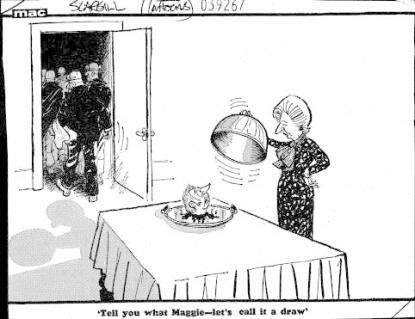
“Head on a Platter,” by Stan McMurtry (“Mac”), published in the Daily Mail, March 4, 1985.
* * * *
A recurring theme in the political cartoons of Thatcher is the popular “Iron Lady”-with-a-lethal purse:
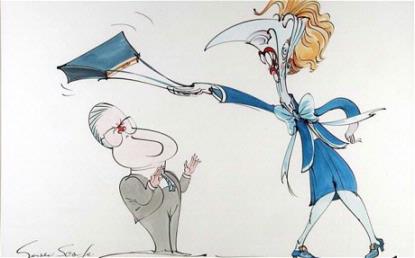
By Gerald Scarfe, famous for illustrating Pink Floyd’s The Wall, and a long-time illustrator for the Sunday Times and the New Yorker.
In contrast, Leslie Gibbard’s cartoon of Ronald Reagan tossing a brick at a beehive captures antoher recurring theme in the cartoons of Thatcher and Reagan: Thatcher’s strong regard for Reagan. The cartoon below is referring to England giving permission to the U.S. to launch American war planes from British bases to attack Libya in April, 1986. The bombing resulted in the destruction of Col. Muammar Gaddafi’s home, where one of his children was killed.
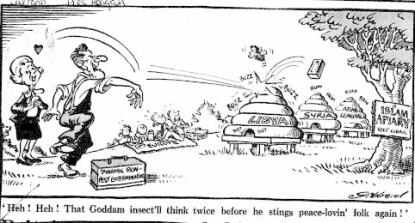
The cartoonist, Leslie Gibbard, another New Zealander, began his career in the early 60s contributing cartoons for the Auckland Star and the New Zealand Herald. He eventually moved to London and freelanced regularly for the Guardian, which he describes with fondness: “The Guardian I joined was a dream shop-window for any cartoonist, using the cartoon on either the front or back pages. The cartoon was drawn at the very last minute, long after most other Fleet Street cartoonists with their allocated inside spaces had gone home, and the drawings complemented, summed up and competed with the latest news coverage. I was able to draw to any shape I fancied, the page being designed around the drawing. In time special shapes were requested.”
* * * *
The role of Britain in the European Community, which was beginning to unite and discuss a common currency, was defined by Thatcher and members of her cabinet at the end of her time in office as Prime Minister. Thatcher was staunchly opposed to abandoning the pound and joining a European monetary system (and of course, this independence has held). This position split the Conservatives, some of whom favored integration with a European system.
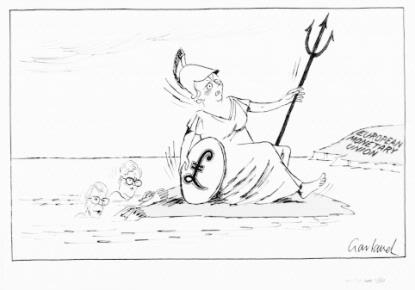
By Nicholas Garland, published in The Independent, June 22, 1990 (the figures pushing Thatcher are John Major, then Chancellor of the Exchequer, and Douglas Hurd, then Minister for Europe)
Growing turbulence in the British economy and a recession led to the erosion of Thatcher’s popularity and trust in her economic policies. In the late 80s, the introduction of a “poll tax” on all individuals, not just property owners, which replaced the income tax, caused protests and riots.
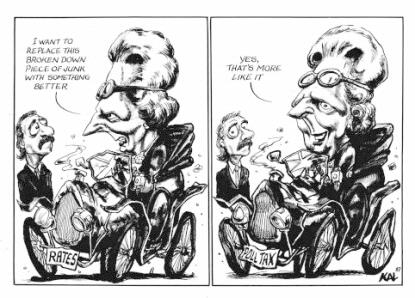
By Kevin Kallaugher (“Kal”), published in Today, July 8, 1987 (note Kal’s self portrait)
Kevin Kallaugher is a Harvard-educated American artist who moved to the UK in 1977, where he originally found work playing semi-professional basketball. After that he worked the streets of Brighton doing caricatures of tourists and shopped his portfolio, eventually landing a gig with the Economist, a magazine with an international readership.
Caricatures of Thatcher were by no means confined to two dimensions—the work of Spitting Image, a puppet-show that was televised in England, was an international sensation at the time (1984-1996). The principal puppet designers were Roger Law and Peter Fluck, both illustrators and sculptors. Their Thatcher was a masterpiece.
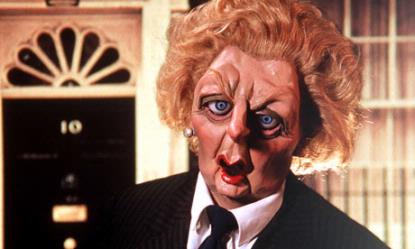
For additional images see the accompanying gallery slide show.


